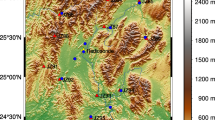Abstract
Precipitable water vapor (PWV) plays an important role in understanding the atmosphere and weather. The advancement in Global Navigation Satellite System (GNSS) technology provides the possibility of computing PWV in near real time. In this study, the PWV was computed using the Zenith Tropospheric Delay (ZTD) from Global Positioning System (GPS) data for two International GNSS Service (IGS) stations (IISC & HYDE) for monsoon period (June–September) of 2014 and 2015. The GPS-derived PWV has been validated with reference to radiosonde data and University NAVSTAR Consortium (UNAVCO) PWV products. The coefficient of determination between GPS-derived PWV and radiosonde PWV is 0.73–0.83 for IISC station and 0.76–0.91 for HYDE station. For IISC station, the coefficient of determination between GPS-derived PWV and UNAVCO-derived PWV is 0.80–0.89. Also, in this study, GPS-derived PWV for IISC station has been compared with the rainfall events of Indian National Satellite System (INSAT-3D). From the analysis, we observed a direct relation between PWV and rainfall events from Hydro Estimator Method (HEM), INSAT Multi spectral Rainfall (IMR) products of INSAT-3D. This study highlights the satellite-based observations from GNSS and INSAT satellite for regional weather forecasting in near real time.










Similar content being viewed by others
References
Coster, A. J., Niell, A. E., Solheim, F. S., Mendes, V.B., Toor, P.C., Langley, R. B., Ruggles, C. A., (1996). The Westford water vapor experiment: Use of GPS to determine total precipitable water vapor, presented at the ION 52nd Annual Meeting, Cambridge, MA 19–21 June 1996.
Bevis, M., Businger, S., Herring, T. A., Rocken, C., Anthes, R. A., & Ware, R. (1992). GPS meteorology: Remote sensing of atmospheric water vapor using the Global Positioning System. Journal of Geophysical Research, 97(D14), 15787–15801.
Bevis, M., Businger, S., & Chiswell, S. (1994). GPS meteorology: Mapping zenith wet delays on to Precipitable water. Journal of Applied Meteorology, 33, 379–386.
Singh, D., Ghosh, J. K., & Kashyap, D. (2012). Development of a site-specific ZHD model using radiosonde data. Acta Geodaetic et Geophsica Hungarica, 47(1), 1–11.
Davis, J. L., Herring, T. A., Shapiro, I. I., Rogers, A. E., & Elgered, G. (1985). Geodesy by radio interferometry: Effects of atmospheric modelling errors on estimates of baseline length. Radio Science, 20, 1593–1607.
INSAT-3D Data Products Catalog, (2014), National Satellite Meteorological Centre, India Meteorological Department, Lodi Road, New Delhi-110003.
Jade, S., Vijayan, M. S. M., Gaur, V. K., Prabhu, T., & Sahu, S. C. (2005). Estimates of precipitable water vapor from GPS data in Indian subcontinent. Journal of Atmospheric and Solar-Terrestrial Physics, 67(6), 623–635.
MATLAB 7.0 and statistics Tool box release(2004). The Mathworks, Inc., Natick Massachusetts, United States.
Rocken, C., Ware, R., Hove, T. V., Solheim, F., Alber, C., Johnson, J., et al. (1993). Sensing atmospheric water vapour with the global positioning system. Geophysical Research Letters, 20(23), 2631–2634.
Rocken, C., Hove, T. V., Johnson, J., Solheim, F., Ware, R., Bevis, M., et al. (1995). GPS/STORM–GPS sensing of atmospheric water vapor for meteorology. Journal of Atmospheric and Oceanic Technology, 12, 468–478.
Rocken, C., Van Hove, T., & Ware, R. (1997). Near real-time GPS sensing of atmospheric water vapor. Geophysical Research Letters, 24(24), 3221–3224.
Rolf Dach, Peter Walser (2015). Bernese GNSS Software Version 5.2 manual
Saastamoinen, J., (1972). Atmospheric correction for the troposphere and stratosphere in radio ranging of satellites, The Use of Artificial Satellites for Geodesy, Geophys. Monogr. Ser. 15 American Geophysical Union, pages 247–251.
Sanjay Kumar, A. K., Singh, A. K., & Prasad and R.P. Singh, . (2009). Annual variability of water vapor from GPS and MODIS data over the Indo-Gangetic Plains. The Journal of Indian Geophysical Union, 13(1), 17–23.
Jade, S., & Vijayan, M. S. M. (2008). GPS-based atmospheric precipitable water vapor estimation using meteorological parameters interpolated from NCEP global reanalysis data. Journal of Geophysical Research, 113(D03106), 2008. https://doi.org/10.1029/2007JD008758.
Suparta, W. (2011). Variability of GPS-Based Precipitable Water Vapor over Antarctica: Comparison Between Observations and Predictions. World Applied Sciences Journal, 12(9), 1597–1604.
aws.imd.gov.in (accessed 30 April 2018).
ftp://ftp.aiub.unibe.ch (accessed 30 April 2018).
http://weather.uwyo.edu/upperair/sounding.html (accessed 30 April 2018).
ftp://cddis.gsfc.nasa.gov (accessed 30 April 2018).
Acknowledgements
We thank IGS for providing GNSS data which was obtained through the online archives of the Crustal Dynamics Data Information System (CDDIS), NASA, Goddard Space Flight Center, Green belt, MD, USA.(ftp://cddis.gsfc.nasa.gov) and also thanked India Meteorological Department for providing Automatic Weather Station data. We extend our sincere thanks to Saritha PK, NRSC. for her support in INSAT-3D (IMR and HEM) rainfall data analysis. The INSAT-3D data are available in the public domain from the portal www.mosdac.gov.in.
Author information
Authors and Affiliations
Corresponding author
Additional information
Publisher's Note
Springer Nature remains neutral with regard to jurisdictional claims in published maps and institutional affiliations.
About this article
Cite this article
Gunti, S., Narendran, J. & Muralikrishnan, S. PWV Estimation Using GPS and its Comparison with INSAT-3D Rainfall Data. J Indian Soc Remote Sens 49, 1453–1460 (2021). https://doi.org/10.1007/s12524-021-01324-7
Received:
Accepted:
Published:
Issue Date:
DOI: https://doi.org/10.1007/s12524-021-01324-7




